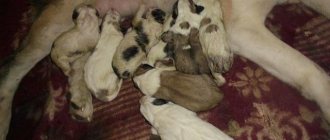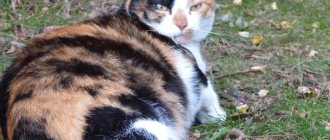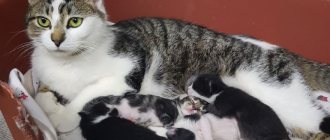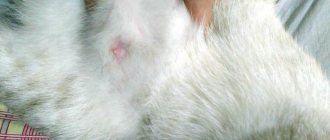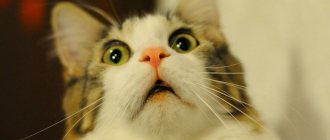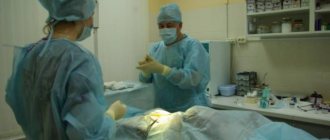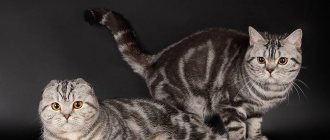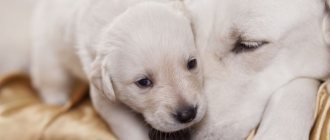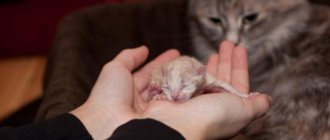After the cat has given birth, a veterinarian must conduct a full detailed examination of the animal. In modern veterinary medicine, several methods are used to examine the general condition of the animal’s body and promptly identify possible complications after childbirth.
Types of complications
After a successful birth, the veterinarian gives a special injection with a hormonal drug - oxytocin. This is necessary in order to stimulate the involution of the uterus (returning the organ to its original pre-pregnancy size), as well as stimulate milk production. It is also necessary to conduct research on milk to avoid various infectious diseases.
For the first 7 days after the animal lambs, it is necessary to constantly monitor body temperature, taking measurements at least once a day. When the temperature rises above 39.6 degrees, you need to sound the alarm. Purulent discharge that lasts more than 2 weeks indicates a serious and dangerous pathological process.
Complications after childbirth include a whole list of pathological conditions:
- acute and congestive mastitis;
- bleeding from the uterine cavity;
- subinvolution of the uterus;
- inversion and prolapse of the uterus;
- eclampsia;
- acute metritis.
Metritis
Metritis is an inflammatory process on the uterine mucosa that occurs due to infection of the birth canal by foreign bacterial pathogens. The onset of the disease can occur immediately after childbirth, or some time after.
Causes
The main factors in the development of acute metritis are delayed delivery of the placenta. The cause of inflammation of the uterine mucosa is the delay of the last dead kitten, which can mummify in the cavity of the reproductive organ. The infection can also penetrate the birth canal if the rules of asepsis and antisepsis are not followed. Obstetric care provided at home with unsterile instruments or dirty hands can provoke the development of infection.
Another common cause of inflammation of the uterus and uterine walls is failure to maintain cleanliness in the nest with kittens, both during the birth process and after it. In order to prevent this postpartum complication, it is recommended to remove blood and placenta, which can serve as an excellent breeding ground for the growth and reproduction of bacterial microorganisms.
Symptoms
The animal looks depressed and lethargic. Body temperatures begin to vary from 39 to 40.7 degrees. The animal has no appetite and shows complete apathy towards what is happening. Such a cat does not lick her kittens and does not monitor their hygiene. The milk produced in the mammary glands of such an animal is not suitable for feeding offspring. Characteristic thick clots and greenish mucus mixed with blood are released from the genitals. Characteristic signs of pathology appear 2–5 days after the end of childbirth.
Note! In the first hours after birth, the cat has a greenish discharge from the vagina. They do not have a characteristic putrid and fetid odor, as in the inflammatory process.
Normal physiological secretions pass without changes in body temperature, diarrhea, eruptions of gastric contents and other characteristic signs of poisoning of the body with products of the vital activity of pathogenic microflora.
Possible complications after childbirth
It happens that after the birth of several kittens, the cat continues to behave restlessly - perhaps in this case not all kittens were born and labor will continue soon. It is more convenient to control this period if the cat was examined during pregnancy and the owners know exactly the number of kittens. If the cat's restless state continues for more than a day and a half, then it needs to be shown to a veterinarian, and ultrasound diagnostics may be required. It is also worth visiting a doctor if your cat has discharge, an increase in body temperature, or vomiting or diarrhea. Normally, a cat may have dark discharge for two to three weeks after giving birth; if there are no other symptoms, then there is no need to worry.
Frequent breathing after birth that lasts more than ten minutes indicates problems with the cat's health.
. In this case, you cannot hesitate and only a doctor can help!
If you don't limit your cat's eating of placenta during birth, it can cause gastrointestinal problems later. Therefore, vomiting and loose stools within one to two days after birth may be normal. In this case, the body temperature of the young mother will be normal and her condition will be calm. If the disorder continues for more than forty-eight hours, the animal should be further examined by a veterinarian. Intestinal disorders can also be in the form of constipation. Therefore, if a cat retains stool after giving birth for more than a day, it is necessary to give her Vaseline oil three times a day before defecation. In case of prolonged constipation, consultation with a veterinarian will be necessary.
Prevention of complications
With the onset of the postpartum period, it is important to provide first aid to the animal in case of deviations from the norm or disturbances in the cat’s well-being. It is important to make sure that all babies have been born and to gently palpate the abdomen to diagnose a remaining placenta or an unborn kitten. It is necessary to pay attention to all the changes that occur with your pet, monitor the emotional state, body temperature, and the presence of discharge.
Note! You should not pick up kittens again. This causes stress for the mother.
Near the nest with kittens you need to place all the attributes necessary for a new mother - a toilet, a bowl of food, clean drinking water.
Movement of kittens towards the cervix
The process of childbirth begins with the appearance of contractions and dilation of the cervix. Contractions are regular involuntary contractions of the muscles of the uterus. Contractions last from several seconds to several minutes. During childbirth, the strength and frequency of uterine contractions gradually increases. Contractions help kittens move towards the cervix. When contractions begin, the cervix dilates and the kittens can pass into the vagina.
The animal experiences pain during uterine contractions and may meow pitifully. At these moments, the pet really needs the support of its owner.
We suggest you read: Scabies mite in cats Types of parasite and methods of treatment
Insufficient force of uterine contractions is a common cause of complications during childbirth in cats. This may be caused by a lack of the hormone oxytocin or calcium in the pet’s body.
Cat won't empty its bladder after giving birth - what to do?
Constipation after childbirth can be a completely expected consequence, but the inability to empty the bladder is always a very alarming symptom. In the “best case”, there may be no urination due to severe dehydration. During the birthing process, the cat quickly loses water, and salt and electrolyte balances are disrupted.
Important! With adequate therapy, dehydration after childbirth can be eliminated within 1–2 days.
To prevent dehydration, your cat should be offered warm drinks frequently during and immediately after birth. In the early stages of dehydration, Ringer's solution helps well, as it helps retain water in the body and saturate it with microelements. If dehydration has reached a severe stage, it can be treated with subcutaneous and intravenous infusions of saline solutions.
Important! Contact your veterinarian immediately if your cat fails to urinate for 2 days or more. Stagnation of urine leads to intoxication and the development of inflammatory processes in the genitourinary system.
A more alarming pathology that leads to the cat being unable to pass urine is urolithiasis. The problem is that a cat can suffer from urolithiasis covertly, but after pregnancy and childbirth, the clinical picture will begin to develop and the condition will worsen. If, when trying to urinate, the cat takes an unnatural position, screams loudly, and ignores the tray - these are the first signs of an exacerbation of urolithiasis. When urine stagnates, due to strong efforts, the cat manages to squeeze out a few drops of urine.
Important! If blood is found in your cat’s urine, contact your veterinarian immediately; this is either urolithiasis or advanced cystitis.
Constipation after childbirth - how to help a cat?
Postpartum constipation in a cat is quite difficult to diagnose, unless it has a chronic or atonic form. With chronic constipation, the cat passes a large amount of feces in the form of dense dry balls. With atonic constipation, the intestines are emptied only after overflowing, and the stool looks bulky and shapeless.
Chronic and atonic types of constipation can be called expected consequences after childbirth, but the condition should in no case be left to chance. With both types of constipation, the cause of the development of the malaise lies in the disruption of intestinal motility.
Due to efforts and overload of the body, peristalsis may work too actively or stop. In addition, as kittens move through the birth canal, the intestinal walls are greatly stretched.
What to do?
Sometimes diseases of which constipation is a symptom may be accompanied by other diseases.
Treatment of a disease whose symptom is constipation can only be prescribed by a doctor. Carrying out examinations on your own at home is problematic and not always effective. But you shouldn’t panic because your pet is unwell either.
What should the owner do first:
- Analyze the cat’s nutrition and behavior over the last 2-3 days. Constipation may have been caused by overeating or eating unwanted foods.
- Feel the stomach. Do not press too hard. Pay attention to the animal’s reaction: does palpation cause pain.
- Give more water, stop feeding.
- If constipation occurs after surgery, go to the hospital without delay.
After analysis and determination of the severity of the symptom, it is prohibited to give any medications. Only a veterinarian can make a final diagnosis, as well as prescribe additional examinations (x-rays, ultrasound examinations, urine tests).
Helping adult cats
Adults may be prescribed enemas with the addition of oil and take laxatives. Directions, purposes, and the name of the drug are prescribed by the veterinarian. Unauthorized use is dangerous for the health and life of the cat and can provoke a worsening of the condition.
Help kittens
If a problem stool is detected in a kitten, its diet, quality of drink and food are analyzed.
If a problem stool is detected in a kitten, its diet is analyzed
The maximum assistance that the owner can provide during a pre-medical examination:
- light massage of the kitten's belly;
- starvation diet;
- drinking plenty of fluids.
If the kitten’s condition worsens or stool does not normalize, urgently seek help from a veterinary clinic.
Important! Do not attempt to treat an animal without the appropriate instructions from a doctor with dosage forms intended for an adult or child.
Enema appointment
Significant results are achieved by using an enema. The method is simple, but it is better not to use it without some practice. The first time is done by a veterinarian.
How to give an enema to a cat with constipation
For the procedure you will need a syringe without a needle and Vaseline oil, chamomile, water. Chamomile decoction can be replaced with saline solution.
Be sure to read:
How often do kittens poop and pee, how many times a day, how to understand that he wants to go to the toilet
How to perform an enema:
- Prepare chamomile decoction or saline solution at the rate of 1 tsp. chamomile or salt per 1 glass of water.
- Give cats a small amount of Vaseline oil 1-1.5 hours before the enema.
- Lubricate the tip of the syringe (the place where the needle is connected) with Vaseline and sunflower oil. Gently insert into the anus. If you have a syringe, the insertion depth should not exceed 1.5-2 cm.
- Pinch the anus with your tail. Keep the animal in your arms in this state for a quarter of an hour.
What to do at home if your cat is constipated?
Significant results are achieved by using an enema.
Douching as a method gives a positive result. But cats don’t like it, as they experience pain during the enema.
Also, frequent use of a syringe as an aid has the opposite effect: the intestines stop functioning normally, and in 75% of cases the procedure provokes the appearance of ulcers.
It is strictly forbidden to use douching if:
- pregnant cat;
- the animal suffers from cardiovascular diseases;
- blood clots and bleeding were noticed;
- there are violations of the integrity of the skin in the genital area.
Important! It is dangerous to resort to self-treatment if frequent constipation occurs.
Exacerbations of pathological processes after childbirth and bleeding - important to know!
Breeding animals are examined for the presence of pathological processes before mating, and there are very logical reasons for this. Bearing offspring, giving birth and feeding kittens is a serious stress for the cat’s body. For at least 3–4 months, the animal’s immunity will be suppressed, which will give a second wind to any secretly developing pathology.
Most often, owners discover bleeding after birth if the cat suffered from urolithiasis before pregnancy. A small amount of blood in the urine after childbirth can be considered normal if traces of blood disappear within 48 hours. If the bleeding intensifies, and discharge appears only with urine, there is a high risk of damage to the genitourinary system.
With an exacerbation of urolithiasis, in addition to bloody inclusions in the urine, you will find that it is painful for the cat to empty the bladder. Symptoms of acute urolithiasis include:
- Unnatural posture when urinating.
- Strong straining that does not result in urination.
- Screams while pushing.
- Urination in drops - the cat is straining, but there is very little urine.
- A sharp increase in temperature.
- Severe anxiety.
We invite you to read: Care and maintenance of a ferret at home: pros and cons
To confirm the diagnosis, you must contact a veterinary clinic and have the animal examined. Without a veterinarian's prescription, you can schedule your pet for an ultrasound of the kidneys and genitourinary system or take a urine test.
As a temporary remedy to relieve an acute condition, herbal veterinary drugs can be used. Carefully read the instructions of the drugs, since some of them are contraindicated when feeding offspring.
Why the cat doesn't go to the toilet in a big way: reasons
Surgery disrupts the normal functioning of all organs
Early detection of constipation in a cat will help prevent a common disorder from developing into a disease. Diseases in animals develop 2 times faster and in 78% of cases lead to death.
Constipation after surgery
Surgery disrupts the normal functioning of all organs, not just the intestines. Delayed bowel movements in this case may be a consequence of the operation.
No therapeutic measures are required. Recovery occurs through dietary nutrition.
After castration
Carrying out this kind of intervention involves the administration of anesthesia and stress for the cat. Owners who are planning to castrate their pet should take into account that the preparatory stage begins 2-3 days in advance.
A preliminary visit to the veterinarian is recommended 7-10 days before the intended operation. After castration, the cat also requires certain conditions of detention and diet.
If you do not follow your doctor's recommendations, constipation will be an inevitable result of surgery. If constipation occurs after castration, the cat should be shown to a specialist.
After childbirth
If constipation occurs after castration, the cat should be shown to a specialist.
Problems with the passage of feces occur before and after lambing. Especially if the birth was difficult, with a large number of kittens. The cause of constipation: compression of all organs by the fetus. After lambing, the body recovers slowly.
Important! Making treatment decisions on your own is dangerous. Constipation is only a symptom that can indicate the development of diseases and disorders that are completely different in nature: overeating, diabetes, thyrotoxicosis, burns of the intestinal mucosa, etc.
Other reasons
The causes of illness can be divided into two types: basic (common) and rare.
Be sure to read:
How many times a day should a cat pee: the norm for an adult animal and kittens, when deviations are safe
The first type includes:
- hernia and inflammatory process that began in the paraanal glands;
- infection with worms;
- dietary changes;
- lack of fluid, poor diet (excessive preference for dry food).
- The cat's activity is below average.
The second type is diseases that require long-term treatment:
- oncology;
- ulcers of the gastrointestinal tract;
- diabetes;
- urolithiasis, etc.
Sometimes diseases, the symptom of which is constipation, can be accompanied by other diseases, for example, cystitis - inflammation of the bladder. With cystitis, cats experience problems with urination.
